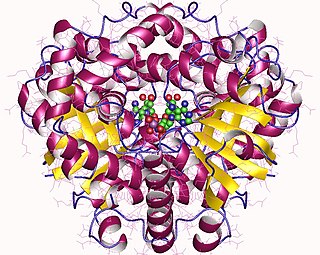| (R)-2-hydroxyacid dehydrogenase | |||||||||
|---|---|---|---|---|---|---|---|---|---|
| Identifiers | |||||||||
| EC no. | 1.1.1.272 | ||||||||
| Databases | |||||||||
| IntEnz | IntEnz view | ||||||||
| BRENDA | BRENDA entry | ||||||||
| ExPASy | NiceZyme view | ||||||||
| KEGG | KEGG entry | ||||||||
| MetaCyc | metabolic pathway | ||||||||
| PRIAM | profile | ||||||||
| PDB structures | RCSB PDB PDBe PDBsum | ||||||||
| Gene Ontology | AmiGO / QuickGO | ||||||||
| |||||||||
In enzymology, a (R)-2-hydroxyacid dehydrogenase (EC 1.1.1.272) is an enzyme that catalyzes the chemical reaction
Contents
- (2R)-3-sulfolactate + NAD(P)+ 3-sulfopyruvate + NAD(P)H + H+
The 3 substrates of this enzyme are (2R)-3-sulfolactic acid, NAD+, and NADP+, whereas its 4 products are 3-sulfopyruvic acid, NADH, NADPH, and H+. This enzyme is important in the metabolism of archaea, particularly their biosynthesis of coenzymes such as coenzyme M, tetrahydromethanopterin and methanofuran. [1]
This enzyme belongs to the family of oxidoreductases, specifically those acting on the CH-OH group of donor with NAD+ or NADP+ as acceptor. The systematic name of this enzyme class is (R)-2-hydroxyacid:NAD(P)+ oxidoreductase. Other names in common use include (R)-sulfolactate:NAD(P)+ oxidoreductase, L-sulfolactate dehydrogenase, ComC, and (R)-sulfolactate dehydrogenase.








